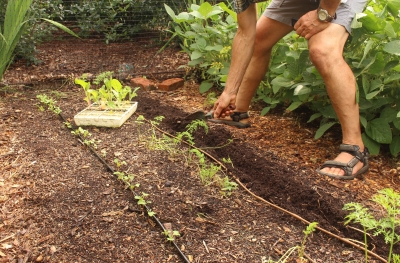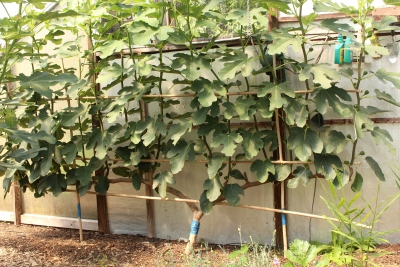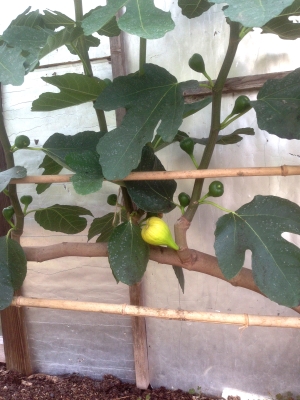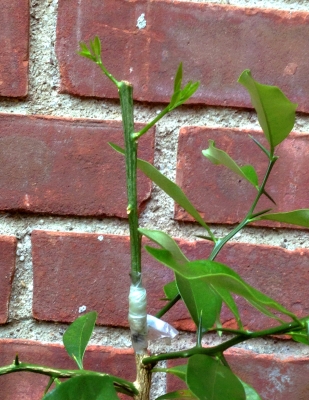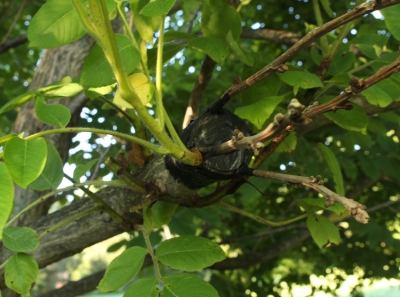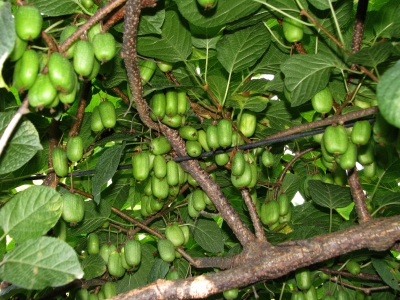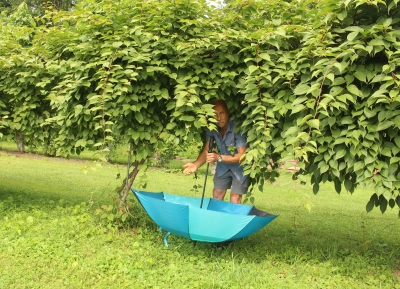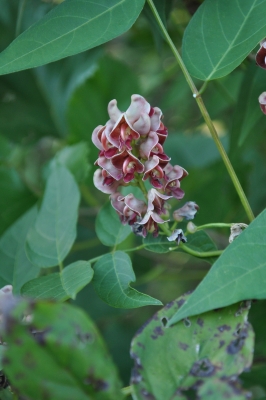HOT DAYS, BUT PREPARING FOR FALL
/7 Comments/in Fruit, Gardening, Planning, Vegetables/by Lee ReichIgnoring My Gut
Like other parents, I don’t hold back preparing for fall just because of hot, sun-drenched sunny days. But my preparations don’t entail trips to the store for notebooks, pencils, rulers, and other school gear. My daughter is old enough to gear up for herself. Instead, I’m preparing for a garden that becomes lush with ”cool weather” vegetables just as tomatoes, peppers, okra, and other warm weather vegetables are fading OUT.
Much of gardening entails NOT going with your gut. If I went with my gut, I’d be planting more tomatoes and sweet corn and, perhaps, if I was really going with my gut, even banana trees on today’s ninety plus degree, bright, sunny, humid day.
Although tomatoes, peppers, and cucumbers presently have more appeal, fall vegetables will have their day. I have to remind myself how a lowering sun and cooler weather make more appealing the lush green leaves of cabbages, brussels sprouts, endive, lettuce, kale, celery, and, below ground, radishes, turnips, carrots, and celeriac. And anyway, I’ll have no choice because summer vegetables will have waned by then.
That lush fall garden, almost like a whole new garden, comes about only if I do something about it now!
To Every Thing There is a Season, a Time to Plant, A Time to…
Timing is (almost) everything for a productive fall garden. Planted too early, some leafy fall vegetables bolt — send up tough seed stalks — because of heat and long days. Right now, I’m sowing turnips and winter radishes, the especially tasty varieties Hakurei and Watermelon respectively. Among leafy, salad vegetables, lettuce, mustard (the variety Mizuna), and endive, with repeated sowing of lettuce every weeks until early September.
It’s still a too early for spinach, arugula, mâche, short season Chinese cabbages, and spring radishes. Some time later this month would be about right for these vegetables. My book, Weedless Gardening, gives a detailed schedule for when to plant what vegetables for specific regions.
For a truly bountiful fall garden, more advance planning was needed. For instance, I won’t be harvesting brussels sprouts until October, but for sprouts lining stalks three to four foot tall, I sowed those seeds indoors in March. Celery and celeriac seed got sprinkled in mini-furrows in seed flats way back in early February.
Zero Tolerance for Weeds, Almost
Almost as important as timing for my fall garden is weeding. The enthusiasm of many gardeners peaks in spring and then slowly wanes as summer heats up. Not mine.
Every time I see a lambsquarters weed, the thought of the eventual 100,000 seeds it might sow prompts be to bend down and yank it out. Same goes for purslane plants, whose seeds remain viable in the soil for decades. And spotted spurge; each plant not only spreads thousands of seeds, but those seeds sprout quickly to mature new plants that make even more baby, then adult, spotted spurges. How could I bring myself not to pull these weeds. (Yes, I know, lambsquarters and purslane are edible — if you like their flavor.)
With weeds kept in check through June, much less effort has been needed to maintain the status quo. Mostly, this is because drier weather has limited weed growth and seed germination, and because any watering in my garden is with drip irrigation. Rather than coaxing weed growth in pathways (and also wasting water), as do sprinklers, drip irrigation pinpoints water to garden plants.
Fresh Figs Bring Me back to Summer
Back to enjoying summer . . . we’ve been enjoying the first crop, known as the breba crop, of figs from the ‘Rabbi Samuel’ fig tree espaliered in the greenhouse.
Most fruit plants bear fruits on one-year-old, or older, stems. Figs, depending on the variety, can bear on one-year-old stems, on new, growing shoots, or on both one-year-old stems and on new, growing shoots. ‘Rabbi Samuel’, I have found, bears on both.
The tree is trained to a T, with two horizontal arms growing in either direction from atop an 18” high trunk. New shoots spring up vertically at about 6 inch spacing along the arms. Late each fall, I cut all those shoots almost back to the arms to make room for and coax new fruiting shoots for the following year.
The stubs left after cutting back the season’s shoots are one year old, and that’s where brebas have been borne. This fall, I’ll leave some a few inches long, for a larger breba crop next July; the next year I’ll shorten them more drastically and leave others a few inches long; and so on, year after year.
The main crop, on new, growing shoots, should begin ripening not to long after the last of the brebas have been harvested. With sufficient sunlight and a bit of supplemental heat in the greenhouse, harvest of the main crop will continue until November’s days grow too short, soothing the transition from the summer to the fall garden.
SPROUTS MAKE ME HAPPY, DARWIN DOESN’T
/1 Comment/in Fruit, Gardening, Vegetables/by Lee ReichMore Citrus in the Making
You wouldn’t think that a couple of small, green sprouts could elicit so much excitement. Especially this time of year, with vigorous, green shoots sprouting up all over the place. But they did, in me. Not that anyone else would notice the two sprouts.
The sprouts were from grafts I made a couple of months ago. Over the years I’ve done hundreds of successful grafts; these two were special.
The first was citrus, special because the trees are subtropical and evergreen. The many apples, pears, and plums that I’ve grafted over the years are deciduous. I graft them when they are leafless and just about ready to start growing. Because the grafts are leafless, the wood, as long as the graft union is sealed, won’t dry out.
Not so for citrus, more specifically for the stems I clipped off my potted Golden Nugget tangerine tree. What was needed, then was a rootstock on which to graft that stem. The result would be a Golden Nugget plant above the graft (which stays right where it is no matter how much the plant grows). Clipping all the leaves from the stem forestalled moisture loss.
My home is also home to kumquat, another citrus that lives in a pot here, outdoors in summer and in a sunny window in winter. A couple of February’s ago, I glanced down at the kumquat seeds I had just spit out from fruits I harvested and ate. Not being able to squander their potential, I planted them in pots. A decade might have gone by before they were old enough to bear fruit but, after two years, the pencil-thick stems were large enough for grafting.
With kumquat rootstocks poised for the operation and Golden Nugget scions (the stem to be grafted atop the rootstock) stripped of leaves and also ready, the procedure was the same as for apple trees and other deciduous plants: matching, sloping cuts on rootstock and scion held in place by a wrapping with a rubber strip; covering the wound to prevent moisture loss. My usual choice of covering is Tree-Kote, which gets painted on, or Parafilm, a stretchy film that adheres to itself.
The citrus scion was fleshy enough to also lose moisture right through the bark. To prevent this, I wrapped the whole scion in the Parafilm. A blackened scion had followed previous attempts at grafting citrus without wrapping the stem.
A week or so ago, it was time to unwrap the Parafilm from around the stem. If the grafted parts were going to knit together, they should have done so by then. Lo and behold, a small, green sprout soon pushed out from the top bud of the scion.
Nutty Grafting
Not all deciduous trees are as easy to graft as apple and pear. Nut trees in the Juglandaceae family, which includes black walnuts, English walnuts, butternuts, pecans, and hickories, are notoriously difficult. Part of the reason is because cutting a stem in spring, which is, of course, unavoidable when grafting, makes these trees bleed, messing up the works.
With a slew of failures at grafting this family under my belt, I needed to try again. The candidate this year was a nut tree called buartnut, and hybrid tree with a hybrid name, the latter a non-euphonious combination of the words “heartnut” and “butternut.” Heartnut is a Japanese species of walnut, notable mostly for how easily it cracks to yield two heart-shaped nutmeats. Butternut is a richly flavored nut borne on a native tree that is becoming increasingly rare because of a blight disease.
Buartnuts allegedly need cross-pollination to bear nuts. My tree, large and spreading though only about 15 years old, lacked a mate. The mate needn’t be a whole other tree; a branch from another tree, grafted on my tree, would suffice and avoid the need to plant a whole new tree or wait the years it would take to flower. Grafted branches bear much more quickly than new trees.
Fortunately, I knew of another buartnut tree that could provide pollination. Last winter, I clipped off a few of its stems, packed them in a plastic bag, wrapped the bag in a wet towel, and then packed that whole mess into another plastic bag and then into the refrigerator. There, they remained hydrated and dormant until needed.
The key, I’ve been told, to grafting Juglandaceae, is to wait in spring until a spate of 80 degree plus weather is predicted. Conditions seemed right on a day last May. Because of past failures, I attempted numerous grafts, three different kinds: the bark graft, the banana graft, and the whip graft. To promote bleeding off-site rather than at the grafts, I slit stems below the grafts. I covered one of the bark grafts with a plastic bag and then, for shade so the stems wouldn’t cook, a paper bag.
Almost all the grafts failed. Except one. Just one stem of just one of the bark grafts (each of these bark grafts carries 4 or 5 stems) sprouted. How exciting!
Temple Disruption
Exciting goings-on in the blueberry patch also. Birds are flitting about every morning, enjoying a few berries despite our repeated efforts to secure any openings in the walk-in “Blueberry Temple.” I threaded some string to more tightly join the top and side netting. As previously, I think this will solve the problem.
Then again, this may be a Darwinian experiment. Birds never used to work their way into the Temple. Openings in the top netting are 1” across; I fear the net is breeding for smaller models of cedar waxwings and catbirds. Or perhaps smarter ones better at finagling their way to the blueberries
DUCKS WORKING, BUT NOT ON GROUNDNUTS
/9 Comments/in Fruit, Gardening, Pests, Vegetables/by Lee ReichTHE DUCKS CALL THIS “WORK”?
My ducks told me that the hardy kiwifruits were ripe. No, they’re not trained to give a specialized “hardy kiwifruit ripe” quack. Instead, they’ve taken to hanging out beneath the vines to scoop up dropped fruits. No training needed for this.
Those dropped fruits are one reason that these vines — Actinidia kolomikta — are not as popular for fruit as another species, Actinidia arguta. Ripening, and dropping, is fast in the heat of July. Arguta kiwis ripen in late summer and early fall, and possibly cling to the vines more reliably then because cooler weather slows ripening.
Not that either of the fruits are well known. Both are cousins to the fuzzy kiwis (A. deliciosa), ubiquitous in supermarkets. Both hardy kiwis differ from the fuzzies in being cold-hardy (only to 0°F for the fuzzy as compared to minus 30°F for A. arguta and to minus 40°F for A. kolomikta), grape-sized, with smooth, edible skins, and better flavor than the fuzzies.
In addition to ripening earlier and dropping more readily, kolomikta kiwis differ from arguta kiwis in coming into bearing much sooner, often in their second year, and growing much less rampantly. Argutas are hard vines to tame. Ornamental vines of both species gracing historic gardens for decades before their fruits were noticed and appreciated is testimonial to their beauty. Kolomikta’s leaves are brushed silvery white with random pink blushes.
Back to harvest. Harvest from the ground is unfeasible because the green fruits are too hard to find among the blades of green grass. And unhealthy because of all the processed kiwifruits — poop — the ducks eject at their far end as they gobble up the berries. A ground cloth to catch the berries would become similarly soiled unless I went to the trouble of spreading it, shaking the vines, then gathering up the cloth after gathering up the fruits.
Instead, I’ve taken to walking beneath the vines with a large umbrella, upturned, and shaking portions of the vines right above the umbrella. Ripe fruit drop into the waiting “funnel.” Sure, many fruits are lost, but the vine bears more than enough to share with the ducks, who can enjoy the missed fruits.
RIPENING OFF THE VINE, HOW CONVENIENT
Like apples, bananas, and avocados, kiwifruits of all stripes are climacteric fruits. Instead of steady ripening, climacteric fruits, just before they are ready to eat, go through a burst of ripening with sugar levels and carbon dioxide production all of a sudden rapidly increasing. Fruit quality begins to decline right after this burst.
Ethylene, a simple gas that is also a naturally occurring plant hormone, also spikes during this burst. And ethylene further accelerates ripening, which increases ethylene production even more, which increases ripening even more, and . . . Disease, wounds, and decay also stimulate ethylene production, which is why “one rotten apple spoils the barrel.”
If picked when sufficiently mature, but not dead ripe, kiwifruits store well for a few weeks. They’ll ripen during storage, slower under refrigeration, faster at room temperature. From experience, I know that “sufficiently mature” for kiwis is when the first fruits start ripening. So, in addition to my umbrella harvesting, I’m harvesting a bunch of the unripe fruits and refrigerating them to extend their season. Don’t worry; there’ll still be plenty for the ducks.
SOMETHING FOR YOU PERMACULTURALISTS
Every time I walk back to the kiwi vines, I pass a perennial flower bed. Or, at least, what was supposed to be a flower bed and now is bordering on half flowers and half weeds. The major two weeds, I admit, are my own doing.
The first of these weeds is dayflower, which arrived here with some bee balm plants from a friend. It’s actually a pretty plant with small, blue flowers, and it’s easy and satisfying to pull out. To a point.
The other weed, groundnut, was a deliberate planting, by me, about 20 years ago. It seemed interesting, bearing edible, golf-ball-sized tubers that string along underground like beads. Groundnut reputedly is the food that got the pilgrim’s through their first winter. Occasionally the plant, a vine, flowers, bearing chains of pale chocolate-colored blossoms. Do I remember them smelling like chocolate also? Perhaps. With all the other vegetation in the bed, the plants haven’t flowered in a long time.
The problem is that those chains of tubers spread to make more chains of tubers which, in turn, do likewise, ad infinitum. The vines now creep over almost every plant in that bed but rarely get enough space to themselves to make tubers anymore. No matter. They didn’t taste that good anyway.
I wasn’t as foolish as might seem planting groundnut in that flower bed. Twenty years ago that flower bed wasn’t a flower bed, but just a place for interesting plants in my then small garden.

